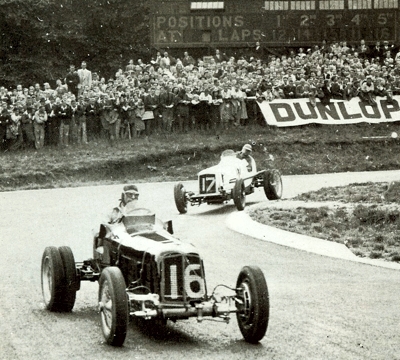Raymond Mays was one of the most prominent British racing drivers of the between-war years. However, not only did he race cars successfully, he also developed the
ERA during the 1930s and, after World War 2, was responsible for instigating the
BRM project.
Born in 1899 at Bourne, Lincolnshire, Raymond Mays 'was the son of a pioneer motorist who used to enter his Napiers and Vauxhalls in early speed events. The young Mays became infatuated with the motor car, and schooling at Oundle and Cambridge was impatiently suffered while schemes were laid to get into motor racing.
Amherst Villiers
He persuaded his father to buy him a Speed Model Hillman whilst at Cambridge and, together with his school friend, Amherst Villiers, he modified the engine considerably. His first event was the Inter-Varsity hill-climb at Aston Clinton in 1921 where the Hillman made best time of the day, a victory which inspired himto modify the Hillman even further so that it could take part in circuit races.
His first race was at Brooklands late in 1921, where he won one handicap race and came second in another. The post-war slump in his father's wool business forced Mays to take a job with another wool firm, but in 1922 he part-exchanged the Hillman against a Bugatti Brescia, paying the balance on instalments.
Together with Amherts Villiers, he modified the Bugatti engine until it was the fastest Brescia around, giving Mays victories in countless hill-climbs. The success came to the notice of Ettore Bugatti who rebuilt the car at the end of the 1923 season free of charge and also gave Mays another Brescia - entirely free.
Cordon Bleu and Cordon Rouge
For 1924, these two cars were named Cordon Bleu and Cordon Rouge after the champagne of that name, and Mays had another successful season. In 1925, Mays was offered a works assisted AC by S. F. Edge. Unfortunately, the car gave considerable trouble and Mays had to use most of a £1000 win on a Victory Bond to pay-off the debt on the car. He worked in his father's wool business during 1926, but in 1927 was asked to drive for Mercedes-Benz of Great Britain, taking the 2-Iitre
Targa Florio model to several victories.
In 1928 Mays used a highly modified 1922 TT Vauxhall, which was tuned by Amherts Villiers to give nearly 300 bhp. This car and an Invicta were kept for several years, bringing him many wins in British events. Both Villiers and his other long-standing friend, Peter Berthon, helped with the development of these cars. Then, in 1933, Mays turned to a Riley. He felt that a suitably modified 1½-litre Riley-engined car would be very competitive.
 Raymond Mays pictured at Crystal Palace driving his famous ERA R4D. Raymond Mays pictured at Crystal Palace driving his famous ERA R4D.
|
ERA - English Racing Automobiles
Fitted into a racing Riley chassis, the 1½-litre engine, with a Murray Jamieson supercharger and tuning by Peter Berthon, proved to be extremely fast, so much so that Humphrey Cook suggested the car would form the basis for a fine single-seater racing car in the Voiturette class. Mays agreed and, with financial backing from Cook, English Racing Automobiles was formed, with premises at Bourne. After a disappointing first outing, the new ERAs began to win race after race, with Mays himself winning all over Europe as well as at Brooklands and Donington. He also won the Shelsley Walsh hill-climb with special ERAs every year from 1934 to 1948 with the exception of 1937.
Arguably his best known victory was his win in the 1935 Eifelrennen at the
Nurburgring, against top continental opposition. In 1939, Mays left
ERA , taking with him his Zoller-blown car, known as R4D, together with 1½ and 2-litre engines. With this car, Mays won at all of Britain's major circuits, putting up lap records, and new best times at hill-climbs. The success of the
ERA in Voiturette racing (what would evolve into Formula Two) fired Mays with a passion to develop a world-beating
Grand Prix car, so he and Peter Berthon formed Automobile Developments Ltd, to try and achieve this ambition, but the intervention of the war put the project on ice for six years.
British Racing Motors
Berthon did however begin design work on the V16 1½-litre engine during the war and, as soon as the war finished, Mays began canvassing the British Industry for financial and material assistance. This was forthcoming and Mays eventually formed British Racing Motors to build and race the car: At the same time, he was still heavily involved in the family wool business as well as running a garage business in Bourne where he sold Bentley, Rover and Ford cars. He also raced his old
ERA R4D mostly in. hill-climbs, where he was still very successful, but the demands of the
BRM project soon forced him to bring his own career to a close.
The
BRM story was one of almost continual failure and humiliation over many years but, when, Sir Alfred Owen took control, the team gradually improved until
Graham Hill won the World Championship in 1962. Raymond Mays involvement in the day-to-day running of the
BRM team gradually lessened, but he was still retained by the Owen organisation in an advisory capacity and even in 1977, at 78, was still attending the occasional race meeting.
Also see: Vauxhall 30/98 Car Review


